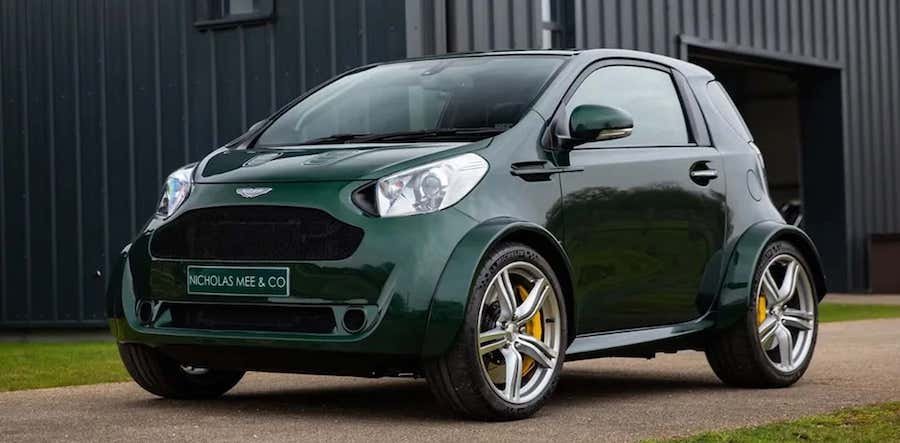Aston Martin V8 Cygnet: The Wildest Factory-Built City Car of All Time

If you never heard about the Aston Martin Cygnet, we don't blame you.
Initially available only in the UK and then in other European markets, the luxurious four-seat city car was only produced by Aston Martin from January 2011 to September 2013.
In case you're wondering, the British carmaker's executives didn't fall on slippery stairs and hit their heads back in the early 2010s.
The model was developed to comply with the European Union's fleet average emissions regulations, which were set to go into effect in 2012.
The Cygnet had some potential, and Aston Martin was expecting to sell an average of 4,000 units a year.
However, the elegant city car became a sales blunder of epic proportions because it was just a facelifted Toyota (Scion) iQ with a lavish interior, one that cost nearly three times as much as the Japanese city car it was based on.
However, about five years after the last Cygnet unceremoniously rolled off the assembly line, Aston Martin debuted a wild one-off that earned universal praise from the press and the brand's loyal following.
Commissioned by an Aston Martin customer
The idea to build a V8-powered Cygnet didn't come from within the company but from an unnamed high-profile customer.
For whatever reason, the customer wanted to own the most unpractical yet awesome city car that the world has ever seen.
The project was handed down to the company's bespoke vehicle customization division dubbed Q by Aston Martin.
Easier said than done
While simply swapping the Cygnet's stock engine with a powerful yet compactly-packed V8 wasn't difficult, the rest of the required modifications surely were.
The team in charge of this special project started with a standard Cygnet body and spent the following months strengthening the structure, adding a roll cage, and transplanting subassemblies from another model.
The city car's chassis had to be modified to accommodate not just the large engine but also the transaxle, which transformed the micro car from FWD to RWD.
The unique Cygnet received front and rear subframes quipped with the fully independent suspension system from the V8 Vantage S.
Though that transplant dramatically improved the V8-powered Cygnet's handling, it took a lot of work to make it fit into the tiny unibody and work around the limited suspension travel.
The two-seat sports car also donated its braking system to the bespoke Cygnet, which became the city car with the largest brake rotors ever fitted from the factory.
Ridiculously wide
While the engineers could do nothing to extend the 78.7-inch (2,000 mm) wheelbase, which was just a bit longer than the car's door, they were forced to modify the track to keep the car from rolling over.
Moreover, the Cygnet's stock 16-inch wheels were swapped for larger 19s wrapped with Michelin Pilot Sport Cup 2 tires, with a width of 235 mm up front and 275 mm at the rear.
These modifications required enlarging the wheel wells and fitting carbon fiber extensions that made the microcar look ridiculously wide.
Apart from the large rims and wheel extensions, the tiny Aston Martin also received a bespoke grille, a hood with twin vents, and a revamped interior.
The latter included fixed Recaro bucket seats, a racing steering wheel, and a custom carbon fiber dashboard.
Amazingly, the engineers managed to equip the car with a small air conditioning unit, but the tiny foldable rear seats that were equipped on the stock model gave way to a larger, 30-liter (7.9-gallon) fuel cell.
Powered by a proper British V8
As I mentioned earlier, the main aim of this project was to stuff a large V8 into the Cygnet's engine bay.
Therefore, instead of the stock 1.3-liter Toyota 1NR-FE inline-four, the Q team managed to squeeze in a 4.7-liter V8.
The motor in question was a naturally aspirated Jaguar AJ-V8, the last British V8 featured in an Aston Martin before the company made the switch to Mercedes-AMG units.
The hand-assembled DOHC all-aluminum engine that came from the 2011–2017 V8 Vantage S was rated at 430 hp, giving the 3,031-pound (1,375-kg) one-off Cygnet a 0.14-hp per pound (313-hp per tonne) power-to-weight ratio.
Ridiculously fast
With all the chassis modifications and the V8 linked to a seven-speed Sportshift II automatic gearbox, the bespoke Cygnet could sprint to 60 mph (97 kph) from a standstill in 42 seconds on its way to a top speed of 170 mph (274 kph).
The insane microcar made its public debut at the 2018 Goodwood Festival of Speed about ten months after the project kicked off, and you can watch it in action below.
Several months later, the one-off was tested by race driver Darren Turner on the Bruntingthorpe runway.
The experienced driver pushed the tiny car to 155 mph (249.4 kph) and stated that he could've gone faster if he hadn't run out of runway.
These days, this insane Aston Martin has popped up on the Nicholas Mee & Co. auction site, where it's marked as reserved.
While the conventional Cygnet went down as Aston Martin's worst series-production model, its unique, V8-powered sibling became one of the wildest, most memorable bespoke vehicles ever created by the British carmaker.




Verwandte Nachrichten
